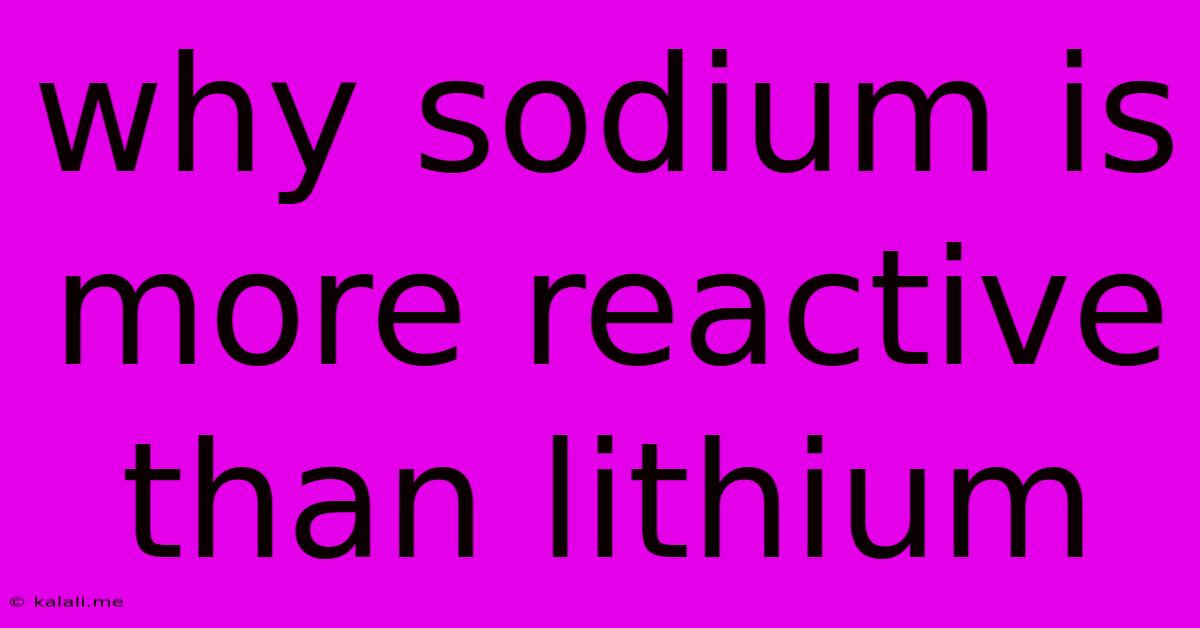Why Sodium Is More Reactive Than Lithium
Kalali
May 20, 2025 · 2 min read

Table of Contents
Why Sodium is More Reactive Than Lithium: A Deeper Dive into Alkali Metal Reactivity
Meta Description: Discover why sodium, despite its larger atomic size, exhibits greater reactivity than lithium. This article explores the factors influencing alkali metal reactivity, including ionization energy and effective nuclear charge.
The alkali metals, group 1 elements in the periodic table, are known for their high reactivity. While lithium (Li) is the lightest alkali metal, its neighbor, sodium (Na), is actually more reactive. This seemingly counterintuitive fact stems from a complex interplay of atomic properties. This article delves into the reasons why sodium surpasses lithium in reactivity, despite its larger atomic radius.
Understanding Alkali Metal Reactivity
Alkali metal reactivity is primarily determined by their ease of losing a single valence electron to achieve a stable noble gas electron configuration. This electron loss is quantified by the element's ionization energy. The lower the ionization energy, the easier it is to remove the electron, and the more reactive the metal.
Ionization Energy and Effective Nuclear Charge
While lithium has a smaller atomic radius, meaning its valence electron is closer to the nucleus, its ionization energy is actually higher than sodium's. This is because lithium's valence electron experiences a stronger effective nuclear charge.
Effective nuclear charge refers to the net positive charge experienced by the valence electron, considering the shielding effect of inner electrons. Lithium, with only two inner electrons, offers minimal shielding to its valence electron. Consequently, the valence electron is more strongly attracted to the nucleus, resulting in a higher ionization energy.
Sodium, on the other hand, has more inner electrons (10) which effectively shield the valence electron from the full positive charge of the nucleus. This reduced effective nuclear charge allows the valence electron in sodium to be more easily removed, leading to a lower ionization energy and thus, higher reactivity.
The Role of Atomic Radius
While atomic radius plays a role, it's not the primary determinant of reactivity in this case. The larger atomic radius of sodium implies a greater distance between the valence electron and the nucleus. However, the significant difference in effective nuclear charge outweighs the effect of the increased distance. The reduced attraction due to the shielding effect in sodium more than compensates for the increased distance.
Summary: Why Sodium is More Reactive
In summary, despite having a larger atomic radius, sodium exhibits higher reactivity than lithium due to a lower ionization energy. This lower ionization energy is a direct consequence of the reduced effective nuclear charge experienced by sodium's valence electron, thanks to the increased shielding effect of its greater number of inner electrons. The interplay between effective nuclear charge and shielding is crucial in understanding the trends in reactivity within the alkali metal group.
Understanding these factors is vital for predicting and explaining the chemical behavior of alkali metals and other elements across the periodic table. Further research into these fundamental principles can enhance our comprehension of chemical bonding and reactivity.
Latest Posts
Latest Posts
-
Countries That Dont Extradite To Uk
May 20, 2025
-
How To Stop A Cat Scratching At A Door
May 20, 2025
-
Depollution System Faulty Peugeot 207 Cc
May 20, 2025
-
Find Size Of File In Linux
May 20, 2025
-
Why Does My Hair Smell Burnt
May 20, 2025
Related Post
Thank you for visiting our website which covers about Why Sodium Is More Reactive Than Lithium . We hope the information provided has been useful to you. Feel free to contact us if you have any questions or need further assistance. See you next time and don't miss to bookmark.